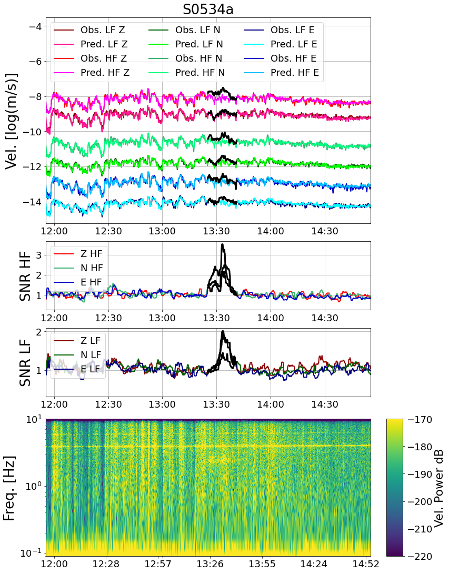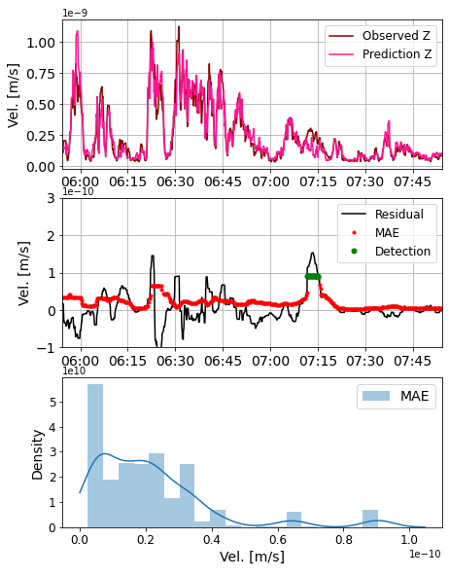Using machine learning to separate atmospherically generated noise from marsquakes
- 1ISAE Supaero, Toulouse, France (alexander.stott@isae-supaero.fr)
- 2LMD/IPSL Sorbonne Université, Paris, France
- 3Imperial College London, London, United Kingdom
- 4University of Bristol, Bristol, United Kingdom
- 5Virginia Tech, Blacksburg, VA, USA
- 6IPGP Université de Paris, Paris, France
- 7ETH Zurich, Zurich, Switzerland
- 8JPL Caltech, Pasadena, CA, USA
Abstract
The seismic data collected by the SEIS (seismic experiment for the interior structure of Mars) [1] package on the NASA InSight mission provide a way to obtain the structure and properties of Mars [2,3]. As the seismometer is installed on the surface, it is also sensitive to atmospherically generated signals from the pressure and wind [4]. These can constrain the ability to observe seismic events. To that end, in Stott et al. 2022 [5], we recently proposed machine learning models to predict the seismic energy from the pressure, wind and temperature data recorded by the dedicated sensors in the APSS (auxiliary payload sensor suite) and TWINS (temperature and wind for InSight) sensor packages. This yields a tool to analyse and discover marsquakes.
A machine learning model for predicting seismic noise
The inputs used for the machine learning model are:
- The pressure and the envelope of the pressure
- The wind speed and direction from two sensor booms
- The air temperature from each sensor boom
These inputs are fed into the machine learning models to predict the seismic velocity energy for the vertical (Z) and horizontal (North and East) axes in the low frequency (0.4-1Hz) and high frequency (2.2-2.6Hz) regions, as these cover the predominant excitations in both categories of marsquakes in the catalogue [6].
Two methods were proposed, the first using gaussian process regression [7] and the second using a neural network [8]. The neural network was found to have superior prediction performance. However, the gaussian process regression model could be used to better dig into the physical relationships between wind, pressure and the ground motion owing to the form and the probabilistic nature of the method.
Marsquake analysis
Figure 1 shows the prediction and observed data for a period containing a marsquake. Before and after the marsquake the observed and predicted data match well, but during the marsquake they diverge indicating the event not to be generated by atmospheric effects. This event is classified as a 2.4Hz event. This class of event typically only exhibits excitation around the 2.4Hz resonance [6,9,10]. However, the prediction in the 0.4-1Hz bandwidth indicates there is some separate energy. Examining the machine learning prediction across the marsquake catalogue shows low frequency energy occurs consistently in the higher frequency classes of events for greater event magnitudes.
Detecting new events and seismic detectivity
The proposed machine learning models identify marsquakes as separate from the background atmospherically generated noise. This can be used to discover new marsquakes as outliers. An algorithm based on this concept was proposed and is demonstrated in Figure 2. Using this approach, a further 32 good candidate events are found along with another 34 suggestions.
Conclusion
Machine learning is a nascent technology in planetary science, whereby it provides a powerful tool to fit datasets using mathematical complexity. Here, we present a model to fit the atmospheric data to the seismic data from the NASA InSight mission. In doing so we
- Provide insights on the relationship between ground motion and the wind, pressure and temperature
- Provide a tool to analyse marsquakes
- Enable the detection of new marsquakes
In this way the machine learning models offer new information about marsquakes and also enable the study of their detectivity to help place constraints on the seismicity of Mars.
References
[1] Lognonné et al. SSR 2019
[2] Giardini et al. Nat. Geosci 2020
[3] Stähler et al. Science 2022
[4] Charalambous et al. JGR: Planets 2021
[5] Stott et al. Submitted 2022
[6] Clinton et al. PEPI 2021
[7] Williams and Rasmussen, MIT Press, 2006
[8] Goodfellow et al. MIT Press 2016
[9] Compaire et al. JGR: Planets 2021
[10] Dahmen et al. BSSA 2021

Figure 1: The S0534a 2.4Hz event with the machine learning model prediction. The top panel shows the observed seismic energy compared to the prediction where the energy during the event is seen to diverge. The second and third panels show the SNR (signal to noise ratio) calculated between the observed and predicted signal for the HF (2.2-2.6Hz) and LF (0.4-1Hz) bandwidths respectively. The bottom panel shows the velocity spectrogram during the event.

Figure 2: Figure showing the detection of a new event with the algorithm in [5]. The top panel shows the prediction from the machine learning model and the observed data. The middle panel shows the detrended residual and the smoothed MAE (mean absolute error) highlighting the outlying points indicating an event. The bottom panel shows the histogram (over a 2 hour window) of the MAE where the points belonging to the event are seen to be outliers in the distribution.
How to cite: Stott, A., Garcia, R., Chédozeau, A., Spiga, A., Murdoch, N., Pinot, B., Mimoun, D., Charalambous, C., Horleston, A., King, S., Kawamura, T., Dahmen, N., Barkaoui, S., Lognonné, P., and Banerdt, W.: Using machine learning to separate atmospherically generated noise from marsquakes, Europlanet Science Congress 2022, Granada, Spain, 18–23 Sep 2022, EPSC2022-833, https://doi.org/10.5194/epsc2022-833, 2022.

